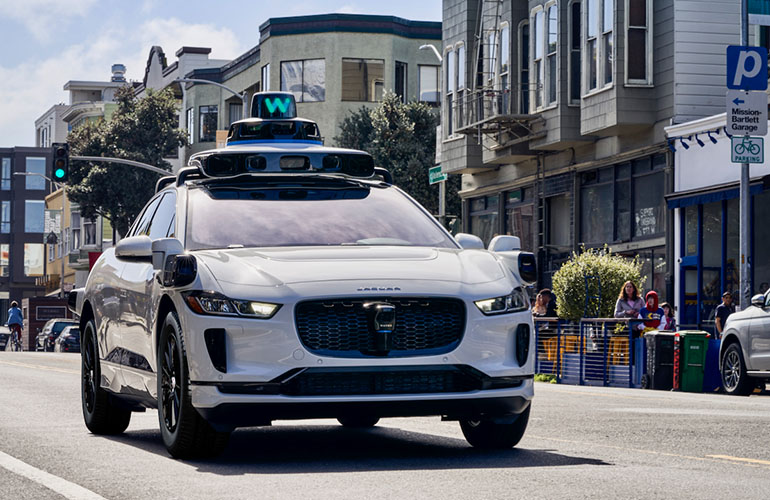|
Listen to this article  |

This lawsuit puts Waymo’s final permit in San Francisco in jeopardy. | Source: Waymo
Robotaxis have had a bumpy ride in San Francisco since companies first began giving public rides in February 2022. Now, the city of San Francisco has filed a lawsuit against the California Public Utilities Commission (CPUC), the organization responsible for regulating autonomous vehicles in the state, to drastically reduce the number of robotaxis on the city’s roads, according to The Washington Post.
The lawsuit centers around the CPUC’s decision in August 2023 to grant both GM’s Cruise and Alphabet’s Waymo their final permits in the state. These permits allowed the companies to charge for rides, expand the hours of operation and service area, and add as many robotaxis to their fleets as they wanted. The lawsuit is asking the CPUC to reconsider its decision and whether it was compliant with the law, according to The Washington Post.
San Francisco city attorney David Chiu filed an administrative motion after the August decision in an attempt to delay Cruise and Waymo from ramping up operations and get another hearing with the CPUC. In December, the City Attorney’s office filed a lawsuit with the California Appellate Court to request the CPUC review its August decision and revoke Waymo’s permit.
“As driverless AVs expanded in San Francisco, members of the public and city officials identified hundreds of safety incidents, including interference with first responders,” the lawsuit said. “Despite these serious safety incidents, and over the objections of San Francisco, the commission approved requests by Cruise and Waymo to operate.”
The lawsuit also asks the CPUC to develop reporting requirements, safety benchmarks, and other public safety regulations to address incidents that have involved first responders, created traffic, and disrupted public transportation.
 Learn from Agility Robotics, Amazon, Disney, Teradyne and many more.
Learn from Agility Robotics, Amazon, Disney, Teradyne and many more.
What does this lawsuit mean?
This lawsuit doesn’t have any impact on Cruise since it already lost its California permits. It does, however, potentially impact Waymo, which still operates in San Francisco. While Waymo hasn’t caused as many high-profile incidents as Cruise, San Francisco officials still have concerns about letting the company have full reign in the city.
Waymo currently has 250 registered cars in its San Francisco fleet, a Waymo spokesperson told The Washington Post, and not all of those are in service at the same time. The company’s ability to increase those numbers whenever it wants is a cause for concern for city officials, according to the lawsuit.
“We are disappointed that the city has chosen to appeal the CPUC’s previous decision, however, we remain confident in our ability to continue safely serving San Francisco’s visitors and residents,” Waymo spokesperson Julia Ilina told The Robot Report. “We have continually demonstrated our deep willingness and longtime commitment to work in partnership with California state regulators, SF city officials and first responders and continue to stand by that approach.
Waymo rolling out robotaxis new cities
Waymo announced on January 19, 2024 that it filed paperwork with the CPUC to “extend our driverless deployment service to include LA.” Waymo has been testing its robotaxis in LA since February 2023. And in October 2023, Waymo started giving free robotaxi rides through areas in Santa Monica, Century City, WeHo, Mid City, K-Town, and finally downtown LA (DTLA). The tour will end in DTLA on March 3, 2024.
At the time, LA was the company’s third city, joining Phoenix and San Francisco. Waymo has had a robotaxi service running in Phoenix since October 2022. And it recently started testing on Phoenix’s highways. So even if the door closes on Waymo in San Francisco, the company is actively expanding to other areas. Waymo told NBC News recently that it already more than 50,000 people on its Los Angeles waitlist for these free rides.
Waymo and the CPUC have until Feb. 16 to file an opposition brief to the December 11 filing. Chiu also filed a lawsuit with California’s Supreme Court. In this lawsuit, Chiu argued the CPUC skirted regulations set by the California Environmental Quality Act by refusing to conduct a review of the environmental impact of its decision to grant Cruise and Waymo their final permits.
Robotaxis hit major milestones and difficult times
The CPUC’s decision in August was a major win for Waymo, Cruise, and the AV industry as a whole. It was the first time a robotaxi company received the green light for practically unlimited operations in a U.S. city. Despite this win, AV companies would begin to hit road bumps soon after, particularly Cruise.
Even before its final permit was granted, Cruise had already issued a voluntary recall of 300 of its vehicles with the National Highway Transportation Safety Administration (NHTSA). The recall was in response to a minor collision where a Cruise robotaxi hit the back of a San Francisco bus. Cruise’s autonomous driving system is also being investigated by NHTSA.
Cruise’s biggest problems started in October, when California officials said Cruise withheld footage of the October 2 incident that shows Cruise’s robotaxi attempting to pull over while the pedestrian was under the vehicle. This maneuver dragged the woman for around 20 feet at a speed of 7 MPH before stopping. Cruise disputes that it withheld footage or information from the DMV, but it paused all of its operations nationwide to reestablish trust with the public.
Following this incident, the California Department of Motor Vehicles (DMV) suspended Cruise’s autonomous vehicle deployment and driverless testing permits. Since this suspension, Cruise’s co-founder and CEO Kyle Vogt resigned, and the company laid off 900 employees, or 24% of its workforce.
Credit: Source link


Comments are closed.